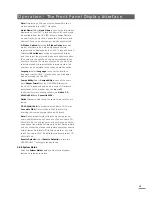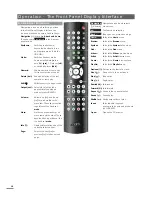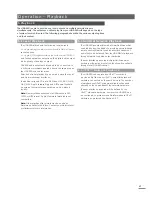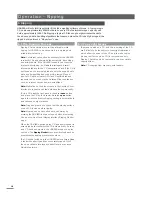
3
Installation - Getting Started
2 Getting Started
The HDX-SSD is a CD-ripping hard disk player and server. It incorporates no built-in
storage but requires an external network attached storage disk drive (a NAS drive) to be
connected and configured before it can be used. Configuring a NAS drive is described in
Section 7 of this manual.
HDX-SSD must be connected to a network to stream music around the home, or to take
advantage of many of its user interfaces. It must also be connected to the internet to
retrieve album data and artwork from the internet, It is important that the network is
working when HDX-SSD is connected and switched on.
HDX-SSD should be installed horizontally on a dedicated equipment stand intended for
the purpose. Do not stand HDX-SSD directly on top of another item of equipment. HDX-SSD
should be installed in its final location before connecting cables or switching on.
Locally connected audio amplifiers should not be switched on before HDX-SSD is switched
on. The HDX-SSD power switch is located on the rear panel.
To begin installation first identify the rear panel network, audio output and power input
sockets, and connect the appropriate cables.
2.1 Internet/Network Connections
Unitiserve-SSD requires a connection to network attached
storage in order to operate, and an “always on” internet
connection if its full capabilities are to be realised. It should
be connected to the internet via an ethernet router/
modem with a built-in firewall
The network connection also enables HDX-SSD to
communicate with other network devices, to be used in a
NaimNet/StreamNet network audio system, and provides
access to its alternative user interfaces.
The HDX-SSD is set up when originally shipped not to
require any further network configuration but to connect
to a network automatically (it uses DHCP by default).
However, if your HDX-SSD has been previously used, its
network configuration may have been altered leaving it
unable to connect automatically. Contact your retailer,
installer or Naim Audio directly if this appears to be the
case.
2.1.1 Network Hardware
Wired network connection is strongly recommended for
the most consistent and secure HDX-SSD operation.
Ethernet-over-mains hardware may be used and provides
a simple and convenient method of home network
connection. However, depending on mains wiring factors
specific to each home environment, the presence of
network data on the mains supply may compromise
overall system sound quality. If any sound quality
compromise is found to be unacceptable, dedicated
network cabling should be installed.
2.2 Power Supply Upgrade
The HDX-SSD can be upgraded through the use of an
external Naim XPS or CD555PS external power supply to
power its analogue circuits.
If an external power supply is to be used, the link plug in
the rear panel of the HDX-SSD should be removed and the
power supply connected in its place using an SXPS Burndy
cable. See Diagram 3.3.
THE SXPS BURNDY CABLE ONLY MUST BE USED TO CONNECT
THE XPS OR 555PS POWER SUPPLIES.
Both the HDX-SSD and the external power supply must be
switched off when the link plug is removed and the Burndy
connections are made. Switch on the external power
supply first followed by the HDX-SSD.
2.3 Audio Connections
Connect one or all of the analogue
DIN
(output 1)
or
Phono
(output 2) output sockets
,
or the
Digital
output
socket
,
to an appropriate audio system input. If using the
analogue outputs use a Naim Hi-Line interconnect cable
for best results.
Note:
The output selector on the rear panel should be
switched to reflect the analogue output connections used.
2.3.1 Signal Ground
Switch the HDX-SSD’s rear panel
Signal Ground
switch (see
paragraph 3.2.14) to the
Chassis
position unless the HDX-
SSD is connected in a hi-fi system incorporating another
earthed source component, or mains “hum” is audible
through the loudspeakers. Contact your retailer, distributor
or Naim for advice if necessary.
Note:
All Naim CD players are earthed so the Signal
ground switch should be set to floating if one is connected
in the system.
Note:
“Connected” in this context means an analogue
audio signal cable that includes an earth connection.






































